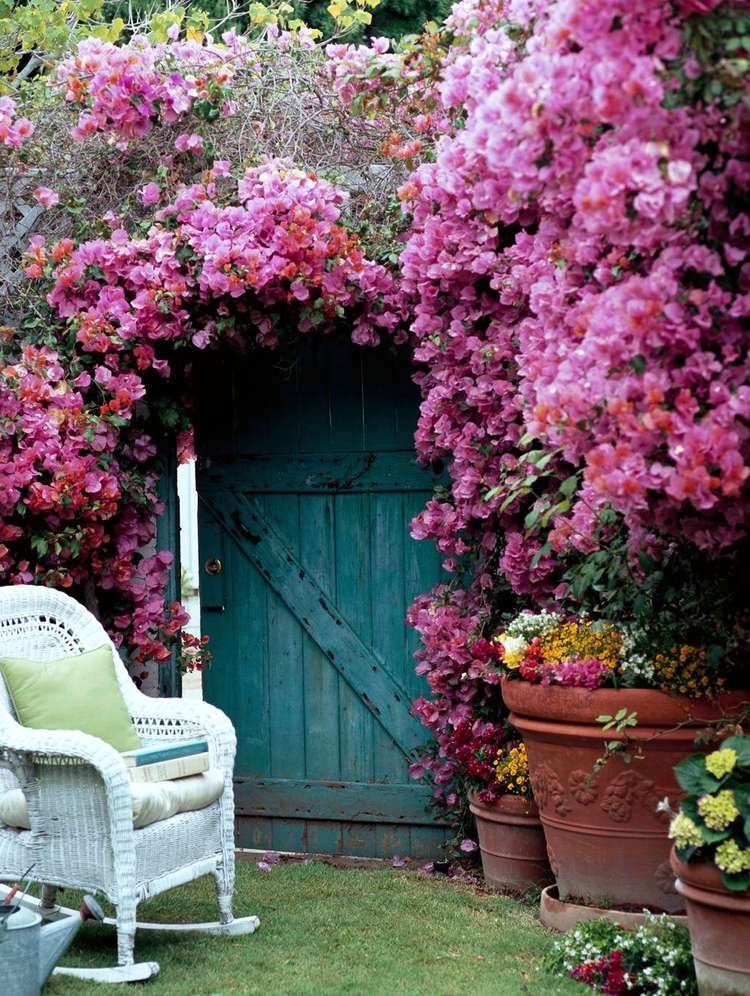If you’re looking for a hardy tropical vine with lots of color, you’ve found it. Bougainvillea is a tough-as-nails plant, and that includes its nail-like thorns. The vine’s hardiness is balanced by its beauty—bougainvillea puts on a spectacular show of color in spring with fresh new growth.
What many people think of as the blooms of bougainvillea aren’t blooms at all. The showy paper-like structures are modified leaves called bracts. These bracts hide the flowers inside, which are small and trumpet-shaped in shades of white and yellow. Bougainvillea is a stellar choice for gardens lacking height, as the plant grows up to an astounding 40 feet.
Bougainvillea Overview
| Genus Name | Bougainvillea |
| Common Name | Bougainvillea |
| Plant Type | Vine |
| Light | Sun |
| Height | 8 to 20 feet |
| Width | 10 to 40 feet |
| Flower Color | Orange, Pink, Purple, Red, White, Yellow |
| Foliage Color | Blue/Green |
| Season Features | Fall Bloom, Reblooming, Spring Bloom, Summer Bloom |
| Special Features | Attracts Birds, Good for Containers, Low Maintenance |
| Zones | 10, 11, 9 |
| Propagation | Stem Cuttings |
| Problem Solvers | Drought Tolerant |
Where to Plant Bougainvillea
Bougainvillea is a tropical plant that thrives in hot, dry climates. In areas colder than Zone 9, it’s grown as an annual or container plant. The woody climber does best next to a fence or supply a trellis when sited in a garden.
How and When to Plant Bougainvillea
Plant bougainvilleas 6 to 9 feet apart in well-draining soil and away from other plants to give it room to grow. Because the plant has sharp thorns, it should be situated several feet away from walkways and other heavily trafficked areas. Spring or summer is the best time to plant bougainvillea, as the time frame allows the vine to develop a strong root system before cool weather returns at the end of the year.
Bougainvillea Care Tips
Bougainvillea is a relatively low-maintenance plant, but it favors certain conditions.
Light
Bougainvillea needs plenty of sun. Some varieties can handle part sun but won’t perform as well as they could in full sun. In less than full sun, bougainvillea will be much more sparse and have a less spectacular flower show, if any at all. Keep your bougainvillea in full sun for maximum blooms and the longest blooming period.
Soil and Water
If you plant bougainvillea in the ground, choose an area with well-drained soil—the vine doesn’t like to remain wet for too long. This plant likes dry soil, so limit watering to every three or four weeks, but water deeply. If you haven’t had a significant show of blooms, try giving your plant a drought period by withholding water. This can sometimes trick bougainvillea into a dormancy period and trigger blooming.
If you’re using bougainvillea as an indoor houseplant, plant it in moist, well-draining potting soil and keep it mostly dry during winter.
Temperature and Humidity
Outdoors, bougainvillea performs best when the temperature is at least 60°F. It tolerates temperatures as high as 95°F and thrives in dry conditions.
When bougainvillea is grown as a houseplant, it likes high humidity of about 50% during the blooming period and lower humidity during the winter.
Fertilizer
Bougainvillea is a heavy feeder. Fertilize the plant monthly during its active growing season. Scratch a granular fertilizer into the soil and water well. If you can’t find a dedicated bougainvillea fertilizer, use a 10-10-10 general-purpose fertilizer.
Pruning
If your bougainvillea is getting out of hand, pruning and maintenance are best done in the fall before a new growth cycle. You can also periodically trim rangy stems as needed throughout the year.
Pests and Problems
The biggest threat to bougainvillea plants in the garden is the appropriately named bougainvillea caterpillar. This 1-inch caterpillar dines on the plant’s foliage, leaving it looking ragged. You probably won’t see this pest because it falls to the ground when you touch the plant. If you see leaves that have been munched on, you can treat bougainvillea with Bacillus thuringiensis.
Training Bougainvillea
When looking for a home for your bougainvillea, think about how you plan to train it. This vigorously growing plant can quickly take over a wall or garden area, but it’s also possible to train and maintain bougainvillea to fit the desired setting. The vine grows well in containers, trained as a shrub, or sprawling as groundcover.
Because of bougainvillea’s woody habit and vigorous growth, the plant lends itself well to manipulation. The most common, especially in tropical areas where plants are hardy, is to allow the vine to climb walls and trellises. This is the simplest way to display the beautiful blooms of bougainvillea.
The plant can also be used in hanging baskets with minimal care. Because bougainvillea doesn’t have tendrils, it needs some coaxing, but no training is necessary as a hanging basket plant.
Types of Bougainvillea
‘Barbara Karst’
Bougainvillea ‘Barbara Karst’ is a particularly popular variety that produces large clusters of red bracts throughout summer and fall. It climbs to 40 feet and is hardy in Zones 9-11.
‘California Gold’
Bougainvillea ‘California Gold’ is one of the best-performing yellow-flowering bougainvillea varieties. It begins blooming as a young plant and produces warm yellow bracts on and off throughout the year. It climbs to 30 feet in Zones 9-10.
‘Juanita Hattan’
Bougainvillea ‘Juanita Hatten’ offers green leaves dotted with gold and bold fuchsia-pink flowers in summer. It climbs to 20 feet and is hardy in Zones 9-10.
‘Sundown Orange’
Bougainvillea ‘Sundown Orange’ offers bracts that begin deep orange, fade to coral, and mature to salmon pink. It blooms in summer and climbs 20 feet tall in Zones 9-11.




















